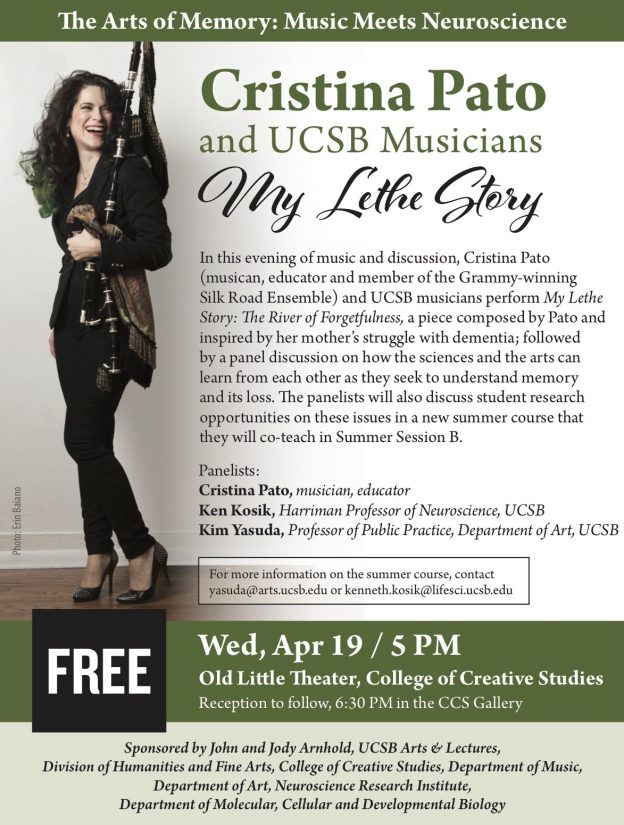With a team of instructors from the fields of neuroscience, music and art, this course introduces students to the emerging cross-disciplinary field of memory studies, while demonstrating how different disciplines approach common questions. Its approach is motivated by the Galician bagpiper and course instructor, Cristina Pato, and the musical composition and story that her mother’s dementia inspired, My Lethe Story. Witnessing how a highly creative musician is both inspired and tormented by her mother’s declining cognitive abilities invites us to consider how tools from the arts, sciences and humanities may be used to explain memory and its loss and to gain understandings of such experiences through the empathy that can be fostered through art, literature and creative expression. We will deal with issues that range from the neuroscientific components of individual memory to the ways that art, music, dance, architecture, and literature express cultural memory, as well as the roles the arts may play in treating conditions that involve temporary or progressive memory loss. Course responsibilities include regular and active participation, a midterm essay, a course journal and a final team project and presentation. Students will learn about current research on memory in different disciplines and, more importantly, work with faculty mentors in translating their new knowledge into projects of diverse types and formats, such as creative or scholarly writing, oral histories, videos, performances, and installations, to name only a few possibilities. Project topics and methods will be determined in consultation with the instructors and will draw upon a broad canvas that includes the neuroscience of memory, computer memory, collective and cultural memories, traumatic memories and artistic representations of memory. With this course, we hope to offer windows on the ways that our diverse experiences and identities can be refracted through the lens of memory.
“Memory: An Interdisciplinary Exploration” is conceived as a transformative pilot course and will be offered in Summer 2017. With a core group of instructors consisting of Cristina Pato (Independent artist and educator), Kenneth S. Kosik (Harriman Professor of Neuroscience, UC Santa Barbara), and Kim Yasuda (Public Practice, Department of Art) and with the collaboration of Mary Hancock (Professor of History and Anthropology and Associate Dean of Humanities and Fine Arts, UC Santa Barbara), the course will explore the scientific, social, literary, and artistic dimensions of memory. Memory is a critically important issue in many different fields: Historians and social scientists have long been interested in how shared memories shape personal and collective identities; neuroscientists are daily developing new models of how memory systems function; and artists are pre-eminent translators of memory into dance, visual imagery and musical expressions. Scholars and creative artists in these different fields, moreover, are increasingly engaged in work that is interdisciplinary—linking scientific studies of memory with art, performance and literature in new and exciting ways, through work in neuroscience, cognitive literary studies, media studies focusing on trauma, and creative activities in public memorial installations. With this first time offering, we intend to provide a unique immersion involving faculty presentations and an investigative lab experience that, together, work through the multitude of paths through memory. We will work with students to build out their own imaginative stories and projects using tools from the arts and humanities, technology, and the social and natural sciences. An interdisciplinary course, especially one incorporating the arts, will draw on our unique resources to address a variety of important issues and questions. Course Aims and Outcomes: We will draw faculty members and visitors from multiple disciplines to integrate a broad spectrum of course material to students. While students will be exposed to a broad swath of material from the sciences, the arts and humanities, they will be encouraged to delve deeply into a topic of interest. In the process we introduce a new model of learning, and will have the opportunity to reflect on how different disciplines approach shared questions related to memory. The course is designed to offer a closely mentored student team experience geared toward the completion of independent projects and will draw upon a broad canvas that includes the neuroscience of memory, computer memory, collective and cultural memories, traumatic memories and artistic rendering of memory. Successful projects will offer windows on the ways that our diverse experiences can be refracted through the lens of memory.
